Carneau Pigeon: The Peak of Exhibition Birds
The Carneau pigeon is a breed of domesticated pigeons historically raised for squab production. Over the years, the purpose of this bird has evolved.
Once raised for meat consumption, fanciers now develop Carneaus for exhibition and show.
And when you look at the Carneau pigeon, it’s clear why these birds are incredible for exhibition. They’re large, robust and have an impressive presence on the stage.
If you’re a fancier who enjoys raising captivating pigeons, the Carneau pigeon could easily be your next project.
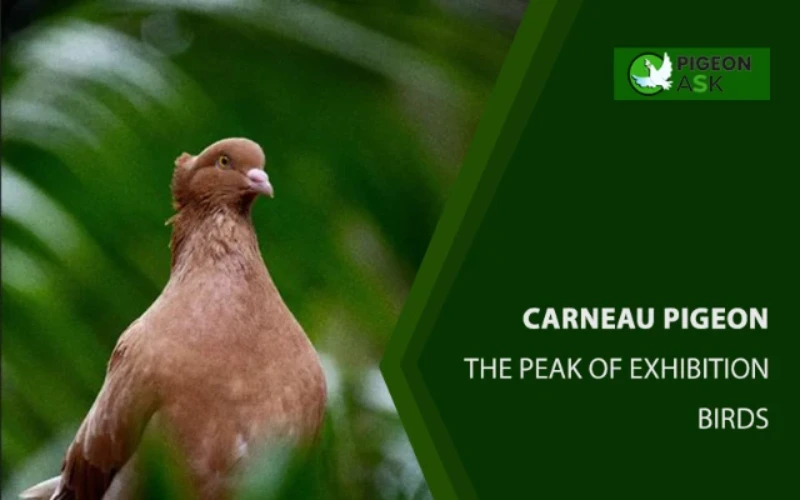
This article covers everything about Carneaus, like their physical traits, typical behavior and how to breed and raise them. Stick around to learn more about this fascinating bird!
Carneau Pigeon Profile
| Name | Carneau Pigeon |
|---|---|
| Scientific Name | Columba livia domestica |
| Common Names | Carneau pigeon |
| Origin | Northern France, southern Belgium area |
| Size | Large, 16 inches |
| Weight | Between 550 (1.2 pounds) and 700 grams (1.50 pounds). |
| Lifespan | Between 7 and 10 years. |
| Physical Features | Large body size, broad and rounded head, prominent eyes, small beak, red cere, thick neck, wide back, strong wings, wedge-shaped tail, red legs, pink skin. |
| Behavior | Docile |
| Special Features | Large and robust body. |
| Breeding and Maintenance | Easy. |
| Common or Popular Varieties | Different colors. |
Interested in similar topics on pigeon breed:
Overview of Carneau Pigeons
The Carneau pigeon is a utility pigeon, a descendant of the rock pigeon or Columbia livia. Historically, fanciers developed this pigeon breed because of its large size, which made it a suitable squab producer.
Nowadays, the purpose of this pigeon is exhibition or as a pet.
Originally, Carneau pigeons were bred as free-flying birds. Over time, they’ve become one of the larger domesticated pigeon breeds, just behind the King Pigeon in size.
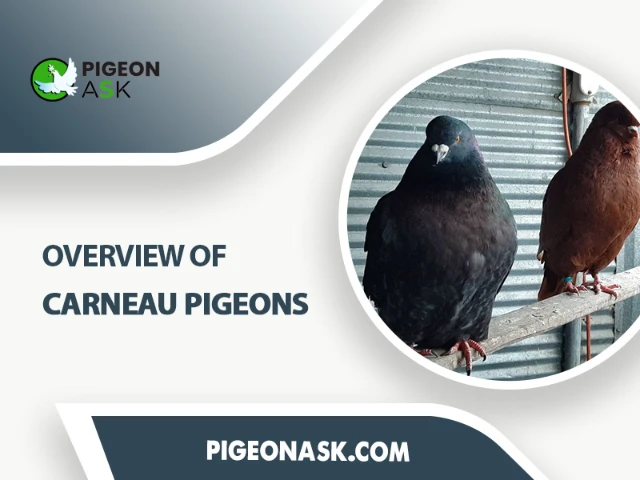
They stand out with their broad heads and come in colors like white, red and yellow. What makes them special is their calm and friendly nature, making them easy to train and handle.
These pigeons have become quite popular in pigeon shows for their impressive appearance and unique qualities. They’re not just showstoppers, though.
Their gentle disposition also makes them great pets for those looking for friendly and easygoing companions.
History and Origins of Carneau Pigeons
Fanciers first developed the Carneau pigeon in France in the 16th century.
More specifically, the pigeon originated in regions close to northern France and southern Belgium.
In fact, it was during the 20th century when Carneaus became massively popular. Fanciers created the Carneau Club Francais in 1933 and the Carneau Pigeon book came out in 1910.
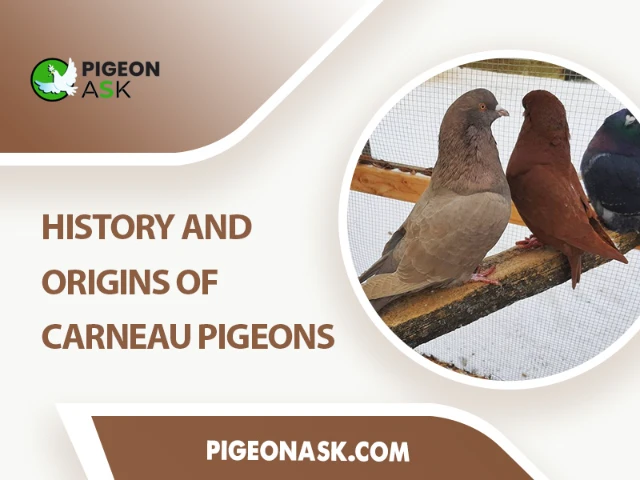
This bird is the result of selective breeding, allegedly from crossing the French mountain pigeons with rock doves or common pigeons.
Originally, fanciers bred Carneaus because of their meat and the birds actually had good flying ability.
Over the years, these motives changed. Now, the general use for this pigeon is utility and exhibition because of its beautiful physical features.
Physical Characteristics and Features
Carneau pigeons are fancy birds and physical features are essential while breeding them.
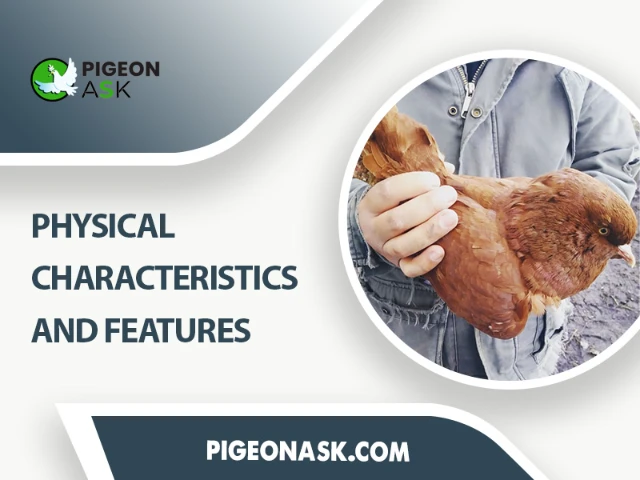
Here’s a breakdown of the typical characteristics of this bird to help you identify it –
| Features Name | Physical Features |
|---|---|
| Head | The head is broad, with a round shape starting at the wattle and ending above the eye. After, the head slopes down over the nape of the neck |
| Eyes | Prominent, rounded eyes. The eyes are also bright and the color varies depending on the pigeon’s color |
| Beak | Small and stout |
| Cere | A red, rounded cere with a fine texture |
| Neck | Strong, thick neck |
| Back | Broad near the shoulder area, turning into a wedge-shaped back down to the tail |
| Wings | Firm and strong feathers, generally kept close to the body |
| Tail | Wedge-shaped tail |
| Legs | Red in color and featherless |
| Skin | Pink |
Size and Weight
The Carneau pigeon is a stout bird with a large body shape and robust build. Typically, this pigeon measures approximately 16 inches and weighs between 550 (1.2 pounds) and 700 grams (1.50 pounds).
Some Common Variations
The Carneau pigeon can be of different colors, including red, yellow, white and reddish or brownish. However, the standards for this pigeon breed are very specific.
Carneau Pigeon General Standards
| Color | Complement |
|---|---|
| Red/Yellow | White wing rose |
| Red/Yellow | White lower back |
| Red/Yellow | White wing rose White lower back |
This pigeon breed is primarily for exhibition nowadays, meaning the color is crucial. It should be intense to create a captivating sheen.
Distribution And Habitat
Let’s analyze the usual distribution and habitat preferences of Carneau pigeons.
Geographic Distribution
The Carneau pigeon is a popular pigeon breed in many parts of the world, but more specifically in France and Belgium. Also, Carneaus are prevalent in the United States and the United Kingdom.
Habitat Preferences
This breed of pigeon can adapt to different environments, but the birds mostly prefer urban and rural environments with warm weather.
Threats and Conservation Status
Even though the population of Carneau pigeons has decreased over the years, these birds are not an endangered species.
Behavior And Traits of Carneau Pigeons
Carneau pigeons are actually calm and gentle, showing a docile temperament that makes them ideal birds to raise and pet.
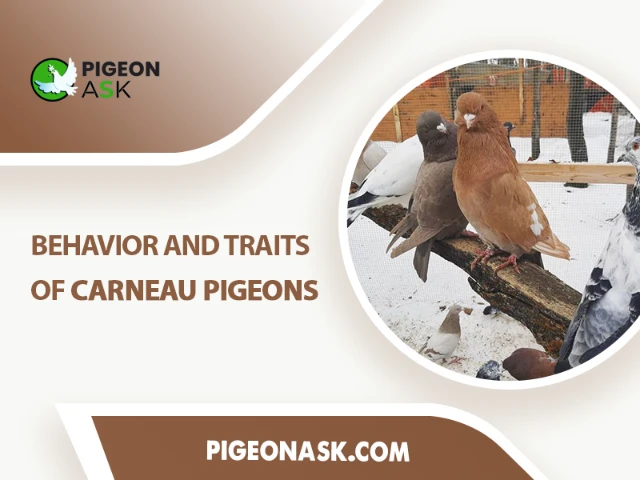
Additionally, these pigeons can be super smart, offering the opportunity to handle and train them with ease.
Differences Between Wild and Domesticated Pigeons
Carneaus have higher chances of survival in captivity. Compared to wild Carneaus, the domesticated ones are heavier and bigger because of a better diet. Also, properly cared birds could live up to 20 years.
Diet
The diet of Carneau pigeons is standard, consisting of pigeon feed and supplemented with other food. For example, you can feed them fruits, veggies, mealworms, nuts and berries to secure that extra vitamin input.
These items should provide a balanced mixture of protein, carbohydrates, fibre and fat.
Likewise, you must provide a bowl of fresh water and grit. The pigeons will use the water to keep themselves hydrated and clean, whereas the grit will help them digest food easier.
Flight
The flying capacity of a Carneau pigeon is good, but these birds don’t feel motivated to fly long distances. They prefer short distances, usually within a secured perimeter in the aviary.
This is also because the bird became heavier and more inclined to remain close to home after years of domestication.
Breeding
Carneau pigeons reach maturity and can reproduce when they are six months old, but some may take up to eight months.
Like other birds, males and females of this breed select a partner and will likely mate for life. The mating pair usually prefer the spring season for breeding.
After mating, the female lays two eggs, and both parents take time to incubate them, which is from 17 to 19 days. Also, these pigeons are good parents and will take good care of the younglings.
Lifespan
The average lifespan of Carneau pigeons is between 7 and 10 years.
Ultimately, how long the pigeon lives will depend on how well you care for it. Provide a healthy diet and keep predators away to ensure your pigeons live their lives to the fullest.
Homing Instinct
The Carneau pigeon does not have a strong homing instinct. If you take good care of them, the pigeons prefer staying in their aviary. This is beneficial because this bird is more suitable for show and exhibition.
Breeding And Maintenance
Carneau pigeons thrive in captivity and are excellent domesticated birds, but proper maintenance is necessary to keep them healthy.
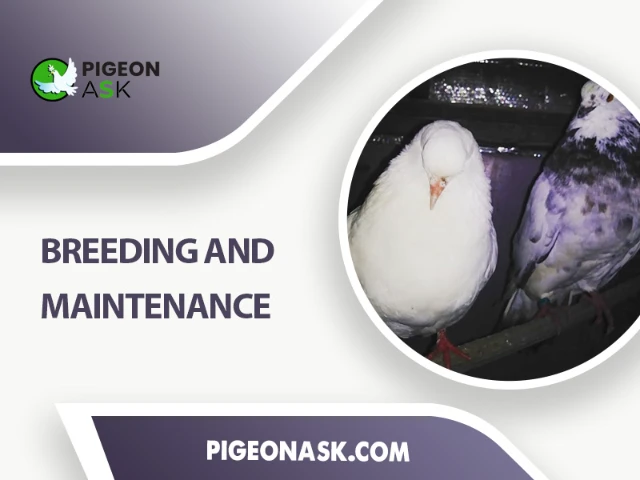
Clean the floor regularly and prevent waste buildup to reduce risks of avian pox, mites and other illnesses. Fortunately, these are standard maintenance tasks that you can do in minutes.
Some Tips and Considerations for Successful Breeding
- Breeding Carneaus requires knowledge, dedication and patience. However, this breed is the most satisfying to raise if you enjoy birds with an impressive appearance for exhibition.
- Select the mating pair wisely. Consider the desirable physical features you expect in the offpsring and make sure the parents are intense and rich in color.
- These pigeons form strong, monogamous relationships. Therefore, keep them together to guarantee they’re comfortable and avoid stress.
- The female Carneau can lay around eight clutches yearly. While the parents take good care of the chicks, some attention may be necessary to keep the eggs safe during incubation.
Housing and Feeding Requirements
A loft or aviary is the ideal housing for the Carneau pigeon. These areas provide everything the pigeons need, like enough space to open their wings and walk around.
Additionally, this area must have proper ventilation and protection to guard the birds from harsh environments and predators.
Those are the main requirements to create comfortable housing for the Carneau pigeon.
You can also include other additions, like a perch or nesting box, which will entertain the pigeons and allow them to exercise regularly.
Feeding
Generally, feeding Carneau pigeons is as easy as feeding other pigeon breeds. Fill a recipient with the food or spread it on a metal sheet and then insert it inside the aviary.
The pigeons will do the rest and eat and then consume the grit later to improve digestion.
Final Word
The Carneau pigeon is a fascinating bird with an impressive appearance.
While its purpose has changed over time, now these birds are fun and satisfying to breed for exhibition and utility uses.
If you only fancy pigeons as a hobby, you will also enjoy the docile nature of these birds, which makes them good pets.
We believe that there are few birds as captivating as the Carneau pigeon.
Want to learn more about them? Follow us on Facebook, Google News and Twitter to catch up with all of our posts related to the bird world. There’s room for you in this aviary!
